Manish Gupta
HistoryBankQA: Multilingual Temporal Question Answering on Historical Events
Sep 16, 2025Abstract:Temporal reasoning about historical events is a critical skill for NLP tasks like event extraction, historical entity linking, temporal question answering, timeline summarization, temporal event clustering and temporal natural language inference. Yet efforts on benchmarking temporal reasoning capabilities of large language models (LLMs) are rather limited. Existing temporal reasoning datasets are limited in scale, lack multilingual coverage and focus more on contemporary events. To address these limitations, we present HistoryBank, a multilingual database of 10M+ historical events extracted from Wikipedia timeline pages and article infoboxes. Our database provides unprecedented coverage in both historical depth and linguistic breadth with 10 languages. Additionally, we construct a comprehensive question answering benchmark for temporal reasoning across all languages. This benchmark covers a diverse set of 6 temporal QA reasoning tasks, and we evaluate a suite of popular language models (LLaMA-3-8B, Mistral-7B, Gemma-2-9b, Qwen3-8B, GPT4o) to assess their performance on these tasks. As expected GPT4o performs best across all answer types and languages; Gemma-2 outperforms the other small language models. Our work aims to provide a comprehensive resource for advancing multilingual and temporally-aware natural language understanding of historical events. To facilitate further research, we will make our code and datasets publicly available upon acceptance of this paper.
CoCoA: Confidence- and Context-Aware Adaptive Decoding for Resolving Knowledge Conflicts in Large Language Models
Aug 25, 2025Abstract:Faithful generation in large language models (LLMs) is challenged by knowledge conflicts between parametric memory and external context. Existing contrastive decoding methods tuned specifically to handle conflict often lack adaptability and can degrade performance in low conflict settings. We introduce CoCoA (Confidence- and Context-Aware Adaptive Decoding), a novel token-level algorithm for principled conflict resolution and enhanced faithfulness. CoCoA resolves conflict by utilizing confidence-aware measures (entropy gap and contextual peakedness) and the generalized divergence between the parametric and contextual distributions. Crucially, CoCoA maintains strong performance even in low conflict settings. Extensive experiments across multiple LLMs on diverse Question Answering (QA), Summarization, and Long-Form Question Answering (LFQA) benchmarks demonstrate CoCoA's state-of-the-art performance over strong baselines like AdaCAD. It yields significant gains in QA accuracy, up to 9.2 points on average compared to the strong baseline AdaCAD, and improves factuality in summarization and LFQA by up to 2.5 points on average across key benchmarks. Additionally, it demonstrates superior sensitivity to conflict variations. CoCoA enables more informed, context-aware, and ultimately more faithful token generation.
Instruction-Tuned Video-Audio Models Elucidate Functional Specialization in the Brain
Jun 09, 2025Abstract:Recent voxel-wise multimodal brain encoding studies have shown that multimodal large language models (MLLMs) exhibit a higher degree of brain alignment compared to unimodal models in both unimodal and multimodal stimulus settings. More recently, instruction-tuned multimodal models have shown to generate task-specific representations that align strongly with brain activity. However, prior work evaluating the brain alignment of MLLMs has primarily focused on unimodal settings or relied on non-instruction-tuned multimodal models for multimodal stimuli. To address this gap, we investigated brain alignment, that is, measuring the degree of predictivity of neural activity recorded while participants were watching naturalistic movies (video along with audio) with representations derived from MLLMs. We utilized instruction-specific embeddings from six video and two audio instruction-tuned MLLMs. Experiments with 13 video task-specific instructions show that instruction-tuned video MLLMs significantly outperform non-instruction-tuned multimodal (by 15%) and unimodal models (by 20%). Our evaluation of MLLMs for both video and audio tasks using language-guided instructions shows clear disentanglement in task-specific representations from MLLMs, leading to precise differentiation of multimodal functional processing in the brain. We also find that MLLM layers align hierarchically with the brain, with early sensory areas showing strong alignment with early layers, while higher-level visual and language regions align more with middle to late layers. These findings provide clear evidence for the role of task-specific instructions in improving the alignment between brain activity and MLLMs, and open new avenues for mapping joint information processing in both the systems. We make the code publicly available [https://github.com/subbareddy248/mllm_videos].
Correlating instruction-tuning (in multimodal models) with vision-language processing (in the brain)
May 26, 2025Abstract:Transformer-based language models, though not explicitly trained to mimic brain recordings, have demonstrated surprising alignment with brain activity. Progress in these models-through increased size, instruction-tuning, and multimodality-has led to better representational alignment with neural data. Recently, a new class of instruction-tuned multimodal LLMs (MLLMs) have emerged, showing remarkable zero-shot capabilities in open-ended multimodal vision tasks. However, it is unknown whether MLLMs, when prompted with natural instructions, lead to better brain alignment and effectively capture instruction-specific representations. To address this, we first investigate brain alignment, i.e., measuring the degree of predictivity of neural visual activity using text output response embeddings from MLLMs as participants engage in watching natural scenes. Experiments with 10 different instructions show that MLLMs exhibit significantly better brain alignment than vision-only models and perform comparably to non-instruction-tuned multimodal models like CLIP. We also find that while these MLLMs are effective at generating high-quality responses suitable to the task-specific instructions, not all instructions are relevant for brain alignment. Further, by varying instructions, we make the MLLMs encode instruction-specific visual concepts related to the input image. This analysis shows that MLLMs effectively capture count-related and recognition-related concepts, demonstrating strong alignment with brain activity. Notably, the majority of the explained variance of the brain encoding models is shared between MLLM embeddings of image captioning and other instructions. These results suggest that enhancing MLLMs' ability to capture task-specific information could lead to better differentiation between various types of instructions, and thereby improving their precision in predicting brain responses.
* 30 pages, 22 figures, The Thirteenth International Conference on Learning Representations, ICLR-2025, Singapore. https://openreview.net/pdf?id=xkgfLXZ4e0
Multi-modal brain encoding models for multi-modal stimuli
May 26, 2025Abstract:Despite participants engaging in unimodal stimuli, such as watching images or silent videos, recent work has demonstrated that multi-modal Transformer models can predict visual brain activity impressively well, even with incongruent modality representations. This raises the question of how accurately these multi-modal models can predict brain activity when participants are engaged in multi-modal stimuli. As these models grow increasingly popular, their use in studying neural activity provides insights into how our brains respond to such multi-modal naturalistic stimuli, i.e., where it separates and integrates information across modalities through a hierarchy of early sensory regions to higher cognition. We investigate this question by using multiple unimodal and two types of multi-modal models-cross-modal and jointly pretrained-to determine which type of model is more relevant to fMRI brain activity when participants are engaged in watching movies. We observe that both types of multi-modal models show improved alignment in several language and visual regions. This study also helps in identifying which brain regions process unimodal versus multi-modal information. We further investigate the contribution of each modality to multi-modal alignment by carefully removing unimodal features one by one from multi-modal representations, and find that there is additional information beyond the unimodal embeddings that is processed in the visual and language regions. Based on this investigation, we find that while for cross-modal models, their brain alignment is partially attributed to the video modality; for jointly pretrained models, it is partially attributed to both the video and audio modalities. This serves as a strong motivation for the neuroscience community to investigate the interpretability of these models for deepening our understanding of multi-modal information processing in brain.
* 26 pages, 15 figures, The Thirteenth International Conference on Learning Representations, ICLR-2025, Singapore. https://openreview.net/pdf?id=0dELcFHig2
TripCraft: A Benchmark for Spatio-Temporally Fine Grained Travel Planning
Feb 27, 2025



Abstract:Recent advancements in probing Large Language Models (LLMs) have explored their latent potential as personalized travel planning agents, yet existing benchmarks remain limited in real world applicability. Existing datasets, such as TravelPlanner and TravelPlanner+, suffer from semi synthetic data reliance, spatial inconsistencies, and a lack of key travel constraints, making them inadequate for practical itinerary generation. To address these gaps, we introduce TripCraft, a spatiotemporally coherent travel planning dataset that integrates real world constraints, including public transit schedules, event availability, diverse attraction categories, and user personas for enhanced personalization. To evaluate LLM generated plans beyond existing binary validation methods, we propose five continuous evaluation metrics, namely Temporal Meal Score, Temporal Attraction Score, Spatial Score, Ordering Score, and Persona Score which assess itinerary quality across multiple dimensions. Our parameter informed setting significantly enhances meal scheduling, improving the Temporal Meal Score from 61% to 80% in a 7 day scenario. TripCraft establishes a new benchmark for LLM driven personalized travel planning, offering a more realistic, constraint aware framework for itinerary generation. Dataset and Codebase will be made publicly available upon acceptance.
Composite Sketch+Text Queries for Retrieving Objects with Elusive Names and Complex Interactions
Feb 12, 2025
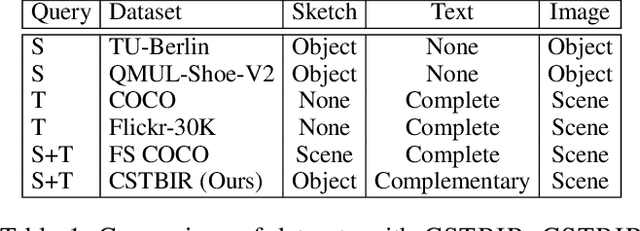

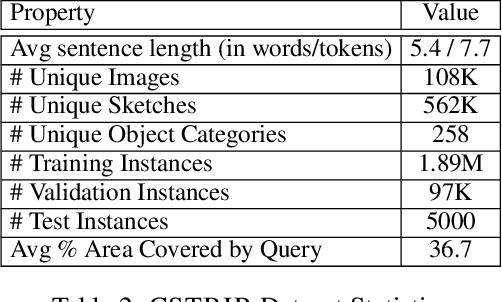
Abstract:Non-native speakers with limited vocabulary often struggle to name specific objects despite being able to visualize them, e.g., people outside Australia searching for numbats. Further, users may want to search for such elusive objects with difficult-to-sketch interactions, e.g., numbat digging in the ground. In such common but complex situations, users desire a search interface that accepts composite multimodal queries comprising hand-drawn sketches of difficult-to-name but easy-to-draw objects and text describing difficult-to-sketch but easy-to-verbalize object attributes or interaction with the scene. This novel problem statement distinctly differs from the previously well-researched TBIR (text-based image retrieval) and SBIR (sketch-based image retrieval) problems. To study this under-explored task, we curate a dataset, CSTBIR (Composite Sketch+Text Based Image Retrieval), consisting of approx. 2M queries and 108K natural scene images. Further, as a solution to this problem, we propose a pretrained multimodal transformer-based baseline, STNET (Sketch+Text Network), that uses a hand-drawn sketch to localize relevant objects in the natural scene image, and encodes the text and image to perform image retrieval. In addition to contrastive learning, we propose multiple training objectives that improve the performance of our model. Extensive experiments show that our proposed method outperforms several state-of-the-art retrieval methods for text-only, sketch-only, and composite query modalities. We make the dataset and code available at our project website.
PatentLMM: Large Multimodal Model for Generating Descriptions for Patent Figures
Jan 25, 2025
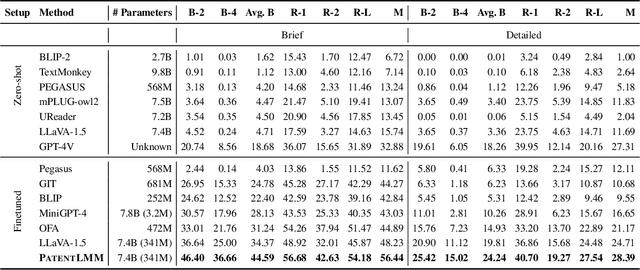
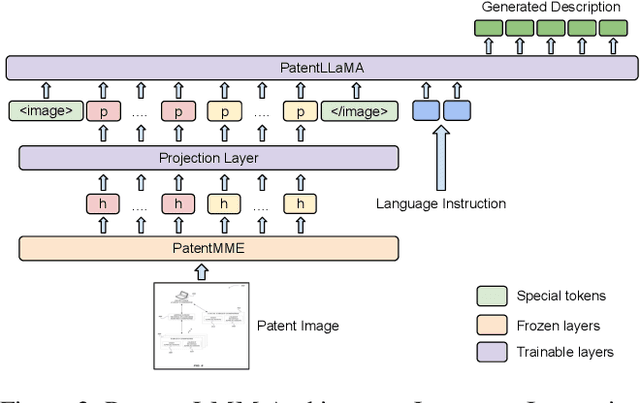

Abstract:Writing comprehensive and accurate descriptions of technical drawings in patent documents is crucial to effective knowledge sharing and enabling the replication and protection of intellectual property. However, automation of this task has been largely overlooked by the research community. To this end, we introduce PatentDesc-355K, a novel large-scale dataset containing ~355K patent figures along with their brief and detailed textual descriptions extracted from more than 60K US patent documents. In addition, we propose PatentLMM - a novel multimodal large language model specifically tailored to generate high-quality descriptions of patent figures. Our proposed PatentLMM comprises two key components: (i) PatentMME, a specialized multimodal vision encoder that captures the unique structural elements of patent figures, and (ii) PatentLLaMA, a domain-adapted version of LLaMA fine-tuned on a large collection of patents. Extensive experiments demonstrate that training a vision encoder specifically designed for patent figures significantly boosts the performance, generating coherent descriptions compared to fine-tuning similar-sized off-the-shelf multimodal models. PatentDesc-355K and PatentLMM pave the way for automating the understanding of patent figures, enabling efficient knowledge sharing and faster drafting of patent documents. We make the code and data publicly available.
Curriculum Learning for Cross-Lingual Data-to-Text Generation With Noisy Data
Dec 18, 2024
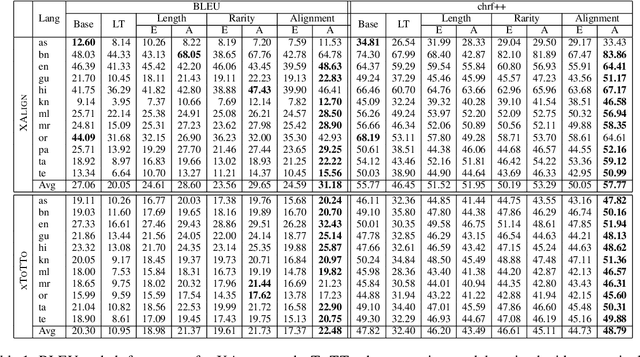


Abstract:Curriculum learning has been used to improve the quality of text generation systems by ordering the training samples according to a particular schedule in various tasks. In the context of data-to-text generation (DTG), previous studies used various difficulty criteria to order the training samples for monolingual DTG. These criteria, however, do not generalize to the crosslingual variant of the problem and do not account for noisy data. We explore multiple criteria that can be used for improving the performance of cross-lingual DTG systems with noisy data using two curriculum schedules. Using the alignment score criterion for ordering samples and an annealing schedule to train the model, we show increase in BLEU score by up to 4 points, and improvements in faithfulness and coverage of generations by 5-15% on average across 11 Indian languages and English in 2 separate datasets. We make code and data publicly available
SCULPT: Systematic Tuning of Long Prompts
Oct 28, 2024
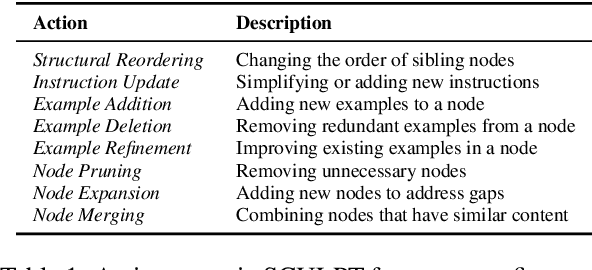


Abstract:As large language models become increasingly central to solving complex tasks, the challenge of optimizing long, unstructured prompts has become critical. Existing optimization techniques often struggle to effectively handle such prompts, leading to suboptimal performance. We introduce SCULPT (Systematic Tuning of Long Prompts), a novel framework that systematically refines long prompts by structuring them hierarchically and applying an iterative actor-critic mechanism. To enhance robustness and generalizability, SCULPT utilizes two complementary feedback mechanisms: Preliminary Assessment, which assesses the prompt's structure before execution, and Error Assessment, which diagnoses and addresses errors post-execution. By aggregating feedback from these mechanisms, SCULPT avoids overfitting and ensures consistent improvements in performance. Our experimental results demonstrate significant accuracy gains and enhanced robustness, particularly in handling erroneous and misaligned prompts. SCULPT consistently outperforms existing approaches, establishing itself as a scalable solution for optimizing long prompts across diverse and real-world tasks.
 Add to Chrome
Add to Chrome Add to Firefox
Add to Firefox Add to Edge
Add to Edge